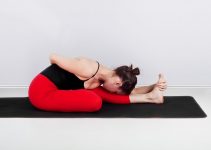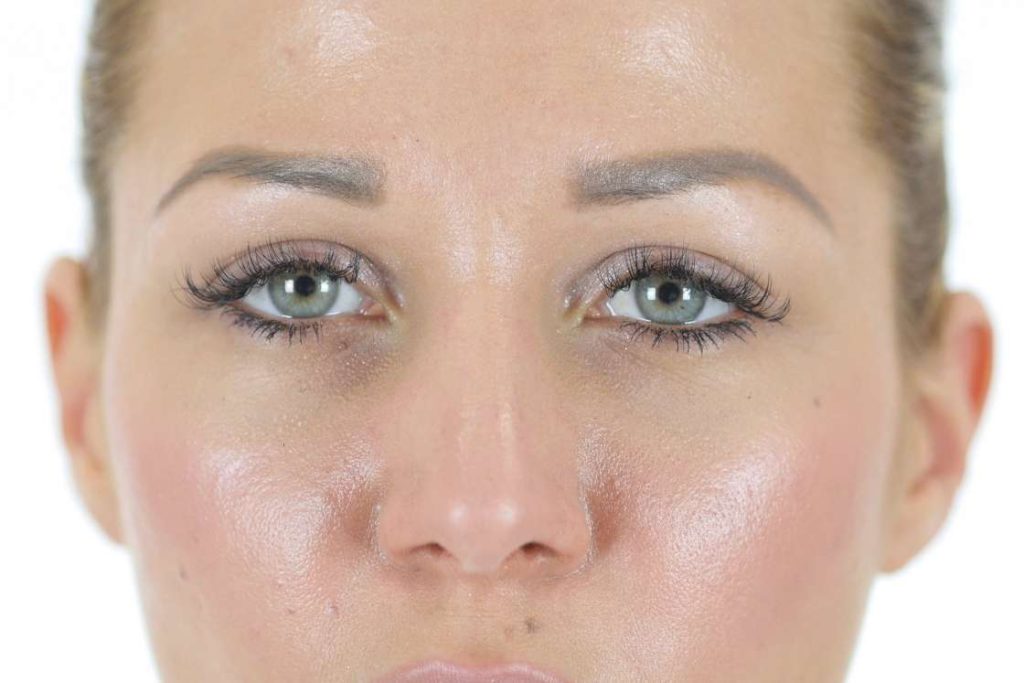
Claiming yoga eye exercises can remove glasses would be too steep. There is no conclusive research to suggest that yoga or any other eye exercise can remove the need for glasses. However, yoga eye exercises can improve your overall ocular health, which could eventually dilute the need for your glasses. Theoretically, there is a thin chance, but practically there are no pieces of evidence.
What science says?
The influence of the yoga eye exercises will depend totally upon the cause and severity of the vision impairment. However, it has been scientifically proven that eye exercises do not harm the eye. The most common causes of vision impairment include, Glaucoma, Trachoma, corneal opacity, diabetic retinopathy, age-related macular degeneration, cataract and uncorrected refractive errors.
To improve eyesight, yoga eye exercises can regulate the pressure in the eye blood vessels, enhance the functioning of the optic nerves, and heal the damaged muscle cells. Moreover, these exercises can stimulate the tear glands, majorly responsible to ward off infections, to function healthily. These benefits collectively help boost your vision. Note, that in severe vision impairments the ocular tissue damage is so extreme, that even yoga eye exercises cannot restore complete healing.
Some studies have shown that Trataka yoga Kriya on patients with refractive error, has improved clarity of vision, contrast sensitivity, and fineness of object. In average cases of vision impairment with symptoms like headache, ocular pain, fatigue, and watering, yoga exercises can improve vision and relieve symptoms by 26-50%.
One of the most important functions that eye yoga exercises provide that lead to many of the benefits, is that it reduces intraocular pressure. A reduced intraocular pressure also helps in eliminating eye fatigue and reduces the chance of glaucoma. The yoga eye exercises also increase the ocular muscle efficiency that contributes to the reduction of fatigue.
Yoga Benefits for Eyes
Yoga for eyes can act as a very good preventive measure and supplement to support your conventional therapy. Eye yoga benefits the reception of the nerves in your eyes, tenacity of your eye muscles, and blood flow to the vessels. These three functions collectively can prove beneficial to your eye health.
- Yoga can relieve digital eye strain. Studies suggest that regular eye yoga exercises can reduce blurry eyes, pain, and dryness that is usual with extensive computer users.
- Yoga trains your ocular muscles for a swift and precise movement that helps you focus faster and sharper.
- Regular practice of yoga will improve the blood flow to your eyes which in turn will provide better nutrition for the light-sensitive cells. This will help you achieve the efficient vision in greater extremes of brightness and darkness. Also, regulating the blood flow in your eyes and maintain optimal pressure in the ocular blood vessels. Reduced intraocular pressure can also help slow the progression of glaucoma
- Yoga can enhance the optic nerves in your eyes for superior motor functions.
- Yoga can give much-needed rest to your eyes, which will help the minute wear and tears in your eyes heal.
- A better cognition through yoga will increase your brain’s ability to interpret what your eyes see. As a result, you will subconsciously become more attentive to what you see, and figure out images faster and better.
- Yoga can also keep your eyes moisturized, oxygenated, and clean.
- Purposeful directional eye movements of yoga will enhance your peripheral vision.
Exercises to Improve Eyesight
The yoga exercises for the eyes are very simple and easy. The yoga for eyes is free of exhaustion but what they do need is conscious effort to execute perfection.
1. Palming

Straining the light-sensitive eye cells aiming is a great way to relax your eyes and rejuvenate them with natural warmth.
Palming will particularly boost the blood flow in the eye, enhancing nutrients availability for eye cells. Palming will help tiny wear and tears in your eyes heal. Eventually, palming will reduce pressure in your eye.
- Sit quietly on a chair or a comfortable cross-legged position.
- Take a few deep breaths to calm yourself.
- Close your eyes.
- Rub the palms of your hand, against each other vigorously to generate warmth.
- Now place your hands on your eyes, and warm them with the heat generated by vigorous rubbing.
- Remove your hands once the heat dissipates.
- Continue this process 3-5 times.
Remember to splash your eyes (closed) with cold water a few times before you start. You must keep your spine, back, and head straight throughout the process.
2. Blinking
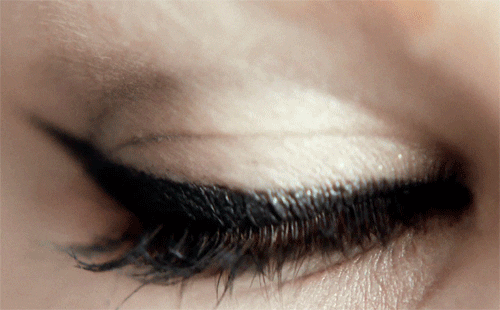
Yes, something as simple as blinking is also an exercise. And, a pretty good one at that. So next time you are staring at the screen for 10-15 minutes straight -do your eyes a favour and blink a couple of times.
Blinking moisturizes your eyes, provides oxygen to the eyes, and cleans the outermost surface of the eye. And finally, every time you blink, your eye is lined with a fresh sheet of tear that gives a sharper and clearer vision.
- Sit comfortably on a chair or a cross-legged position.
- Blink 10 times very quickly.
- Then with your eyes closed, relax for 20 seconds. Breathe attentively.
- Repeat this process 4-5 times.
While blinking it is important that you make every blink a complete blink. That is your upper and lower eyelids come in contact. Otherwise, the desired benefits will not be achieved.
3. Directional viewing
Viewing practices on all extremes of your ocular periphery will train your eye muscles for stability at the extremities. This yoga is highly beneficial for your eye muscles, and can particularly uplift your peripheral vision. The directional viewing follows three different patterns, sideways viewing, rotational viewing, and up and down viewing.
Sideways viewing

- Sit straight comfortably, with your spine and head straight. Preferably sit on a chair or cross-legged on the floor.
- Lift up both your hands Infront of you, make a fist with your thumbs sticking out -pointing upwards.
- Now start by gazing your look straight in between your eyebrows, then shift your gaze to the left thumb, then return to the space between your eyebrows.
- Now gaze at your right thumb, return to the space between your eyebrows and then shift your look to the left thumb.
- At each position hold your gaze for around 2 seconds
- Repeat this exercise 10-20 times.
Inhale on the neutral positions and as you go sideways, exhale. Also, increase the gap between your fists to reach greater extremes.
Up and down viewing

- Sit straight with your legs Infront of you.
- Place both your fists on your knees, with your thumbs sticking out and upward.
- Now slowly, start to lift your right thumb upwards, and as you do so lock your eyesight on the right thumb.
- With focus locked, continue to raise your thumb. Go up to the maximum point your eyesight permits, and then return to the start position.
- Repeat the entire step with your left thumb as well, to complete one round.
- Practice 5 rounds in total.
Relax a bit after finishing this exercise. Pace your thumb movement such, that you can continue to inhale on the rise and exhale on the fall.
Rotational viewing
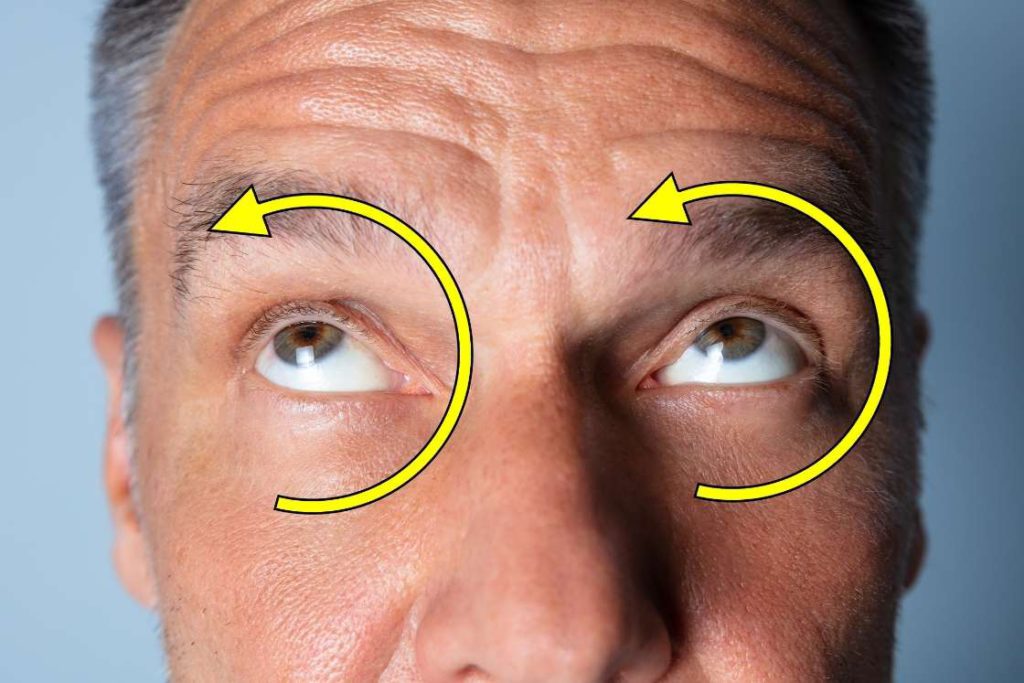
- Sit straight cross-legged on the floor or chair. Spine, head and back straight.
- Place your left hand on your left knee and right fist on your right knee. Your right thumb should point upwards. Keep your elbows straight.
- Fix your gaze upon your right thumb. Now start making a circle with your thumb. As you make the circle, keep your gaze locked on your right thumb.
- Make 5 clockwise circles and 5 counter clockwise. Then repeat the exact with your left thumb.
While making the circles, you should not break your thumb. You can also vary the size of the circle, to train a better range. Inhale as you make the upper arch and exhale as you make the lower arch.
4. Focus shift viewing

Focus shift viewing is a very good exercise for the muscles and ligaments that are responsible for focusing on the eye. This exercise can help us get rid of blurry visions. This exercise can also reduce the chances of nearsightedness and farsightedness.
- Stand or sit in an open area where you have a clear view of the horizon.
- Bring your thumb close to your nose tip, as close as you can focus.
- Focus on the horizon for 10 seconds, and then focus on your thumb for 10 seconds.
- Repeat this exercise for 10-20 times and rest your eyes.
Inhale on close focus and exhale on far focus. Once your muscles are better trained, you can gradually shorten the time to 3 seconds each.
5. Trataka
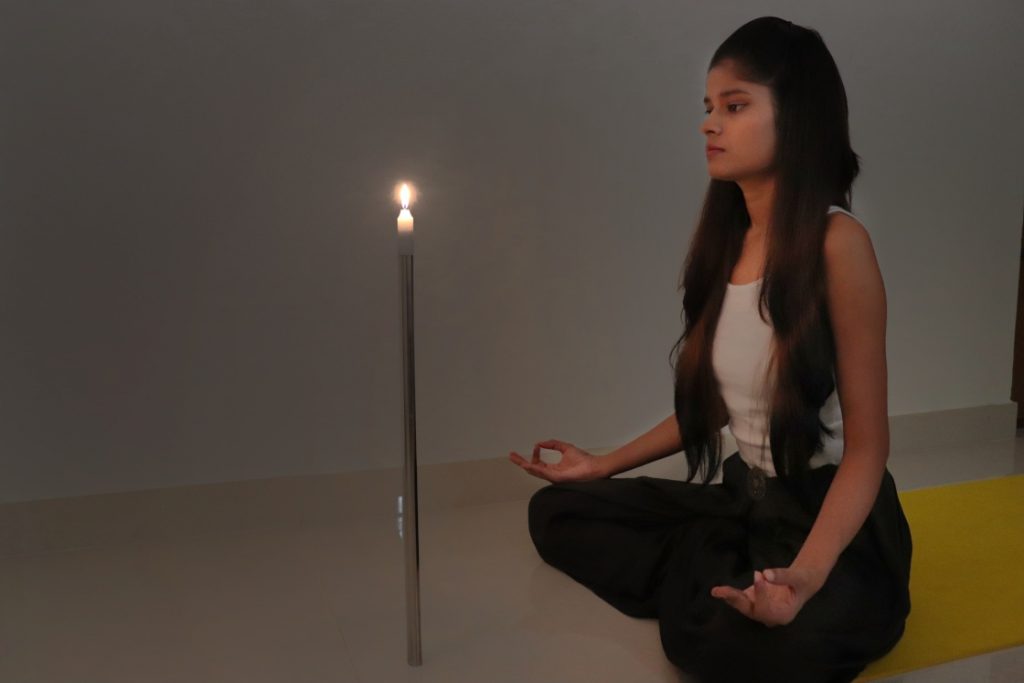
Trataka is a traditional yoga practice for eyes that comes under umbrella of yoga kriyas called Shatkarma.
In trataka, you need to continuously and steadily at a fixed point and at a very close range. This yoga is excellent to train your nerves to be steady and gives your better control over eye movements. It also establishes synchronization between both your eyes. Trataka can lower high myopic power.
- Sit comfortably on a chair or cross-legged on the floor.
- Place a burning candle or an object with a pointed end, approximately 2 feet away from your sitting position.
- Now without blinking, with both your eyes concentrate your gaze towards a single point – the candle flame or the pointed end.
You can do this exercise for as long as you can, but for starters try a minimum of 100 count. Also, count numbers in your mind over setting a stopwatch. Counting numbers will help enhance the concentration.
6. Bhramari Pranayama
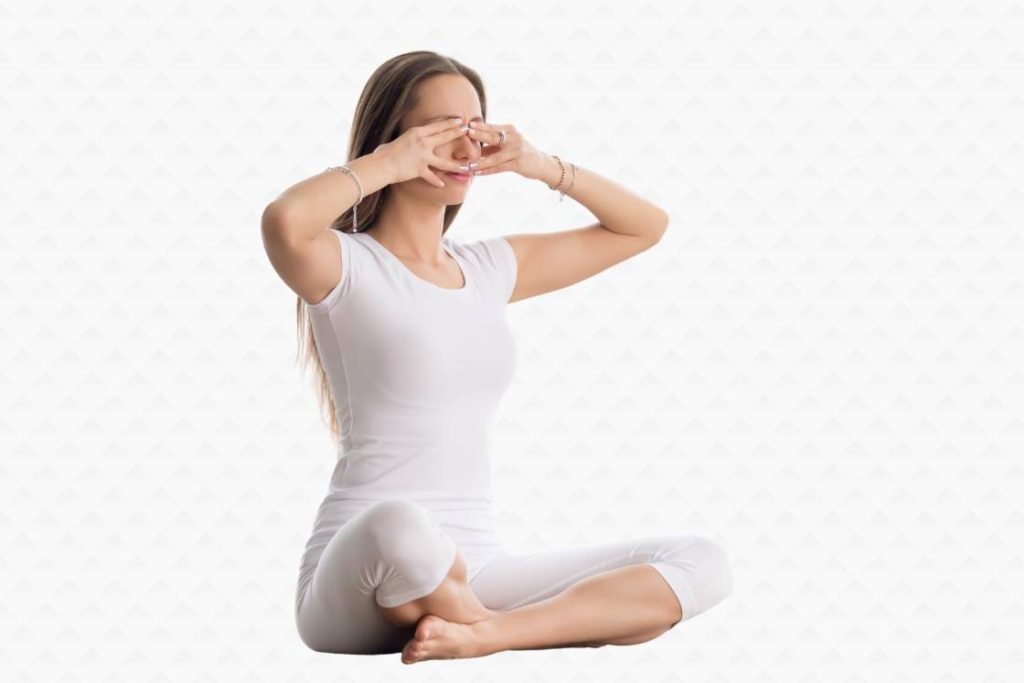
Bhramari is one of the best pranayama exercises for eyes. The calming humble bee sound and hand placement in this pranayama make it perfect for the eyes. It can release stress, strain, and pressure from your head and eyes. This Pranayama has a significant influence on your nervous system as well -which has a critical connection with your eyes.
- Sit on a chair or a comfortable cross-legged position, with your back and head straight.
- Close your eyes and place your thumbs on your ear opening and the rest of your fingers on your eyes, horizontally.
- Take a deep breath in, and then exhale with a humming bee like sound.
- Repeat this process 5 times.
Make sure you don’t press down your eyeballs hard. Instead of placing four fingers on the eye, you can place your index on the eye, the middle on the nose bridge, the ring above the upper lip, your little finger below the lower lip, and the thumb on your ear -the shanmukhi mudra.


